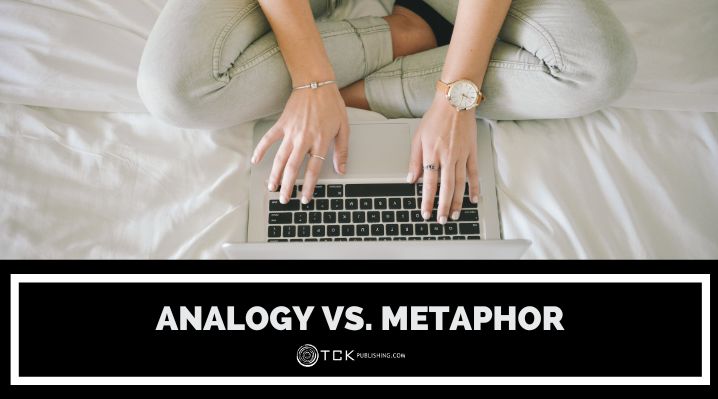
When you think of great writing, what often comes to mind are vivid descriptions and powerful imagery. Behind these elements lies the skillful use of literary devices, like analogy and metaphor.
Many writers spend years honing their use of these tools, often finding new ways to create more engaging and effective prose. And it all starts with learning the differences and similarities between each tool.
What is an Analogy?
An analogy is a logical argument that makes a comparison or shows a connection between two things. It also adds clarity to a specific point of a story or argument through a logical framework.
For example, “Learning to write well is like training for a marathon. It takes time, dedication, and consistent effort to build up your knowledge, skills, and endurance.” Here, the similarities between learning to write and training for a marathon are emphasized. Though they are massively different activities, both require patience and persistence to succeed.
What is a Metaphor?
A metaphor is a figure of speech that compares two things to create deeper meaning or for a more vivid effect. Unlike an analogy, a metaphor is often more poetic and symbolic.
For example, “Without coffee, I am a zombie.” It means that without coffee, the speaker is sluggish and unresponsive, similar to how zombies are often portrayed as slow-moving and lacking vitality.
Key Similarities and Differences
Both analogy and metaphor are used to draw comparisons. They help you explain, illustrate, and enhance your writing by linking familiar concepts with new ideas.
They’re particularly helpful when writing about complex or abstract concepts. By revealing relationships or comparing them with relatable frames of reference, you can deepen your reader’s understanding and make your writing more engaging and accessible.
However, they work differently. For one thing, an analogy is a logical argument, while a metaphor is a figure of speech. Take a look at the examples below.
- Analogy: Time is like a thief in that a thief steals precious objects and time steals precious moments.
- Metaphor: Time is a thief.
An analogy explains its comparison and guides the reader to a logical conclusion. In contrast, a metaphor simply states the comparison, creating a powerful image while letting the reader come to their own conclusion.
As the example also demonstrates, an analogy can incorporate a metaphor to strengthen its impact. By weaving in the imagery and emotion of a metaphor, the analogy becomes more vivid and compelling. This makes its argument more persuasive and compelling.
Examples
Here are some famous examples of analogy and metaphor, taken from books, movies, and popular culture.
Analogy
- “Explaining a joke is like dissecting a frog. You understand it better but the frog dies in the process.”—E. B. White.
- “You see, wire telegraph is a kind of a very, very long cat. You pull his tail in New York and his head is meowing in Los Angeles. Do you understand this? And radio operates exactly the same way: you send signals here, they receive them there. The only difference is that there is no cat.”—Albert Einstein
- “If you want my final opinion on the mystery of life and all that, I can give it to you in a nutshell. The universe is like a safe to which there is a combination. But the combination is locked up in the safe.”—Let Me Count the Ways, Peter De Vries
- “Withdrawal of U.S. troops will become like salted peanuts to the American public; the more U.S. troops come home, the more will be demanded. This could eventually result, in effect, in demands for unilateral withdrawal.”—Henry Kissinger
- “Memory is to love what the saucer is to the cup.”—The House in Paris, Elizabeth Bowen
Metaphor
- “All the world’s a stage, and all the men and women merely players,”—As You Like It, William Shakespeare
- “I took the one less traveled by, and that has made all the difference.”—The Road Not Taken, Robert Frost
- “Hope” is the thing with feathers/ That perches in the soul/ And sings the tune without the words/ And never stops/ at all.—”Hope” is the thing with feathers, Emily Dickinson
- Life is a highway/I want to ride it all night long—Life Is a Highway, Tom Cochrane
- “Conscience is a man’s compass.” —Vincent van Gogh
- “All religions, arts and sciences are branches of the same tree.” — Albert Einstein
When to Use Analogy vs. Metaphor
An analogy makes the reader think and come to a logical conclusion Use it when you need to make a complex or unfamiliar concept more relatable or easier to understand—for example, explaining a new technology by comparing it to something familiar.
A metaphor is a powerful descriptive tool. Use it if you want to stir the reader’s emotions or evoke a particular image. For example, writing “her mind is an ocean” has a stronger visual and emotional impact than “she had a lot of thoughts, ideas, and emotions”.
Common Pitfalls
Even seasoned writers sometimes confuse analogy with metaphor. While they are similar, they are not interchangeable.
Some writers forget to tailor their comparisons to their audience. A well-made comparison fails if your readers can’t understand or relate to it. Make sure your analogies and metaphors always resonate with your audience’s knowledge and experiences.
Other writers rely too much on cliches. Overused phrases lose their effectiveness because of too much familiarity. Sometimes they blend so well into your writing that your readers won’t realize you’re making a comparison. Think of fresh and original ways to compare things so they stand out and stick to your audience’s mind.
Lastly, forced or overly figurative comparisons feel unnatural. While it’s important to be creative, you don’t want to confuse your readers. For example, “His laugh was sandpaper” effectively conveys a harsh, grating sound. In contrast, “His laugh was a rusty chainsaw cutting through fields of cotton candy dreams”, may be imaginative, but its odd imagery muddles its meaning.
Conclusion
Whether you’re explaining a complex idea or painting a vivid picture, knowing when and where to use an analogy or metaphor is key to more effective writing.
Remember, an analogy is for explanation, a metaphor is for illustration. Both add different depths that make your words more engaging in different ways. Experiment with these tools and see how much further you can transform your prose.
How do you use your analogies and metaphors in writing? Share your thoughts below!
If you enjoyed this post, then you might also like:
- How to Use Analogies in Writing: Tips and Examples for Drawing Comparisons
- Introduction to Metaphors: Poetry in Motion
- Extended Metaphors Explained: Definition, Purpose, and Examples from Literature

Cole is a blog writer and aspiring novelist. He has a degree in Communications and is an advocate of media and information literacy and responsible media practices. Aside from his interest in technology, crafts, and food, he’s also your typical science fiction and fantasy junkie, spending most of his free time reading through an ever-growing to-be-read list. It’s either that or procrastinating over actually writing his book. Wish him luck!
